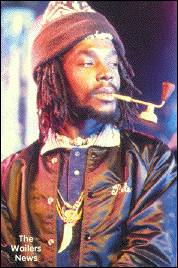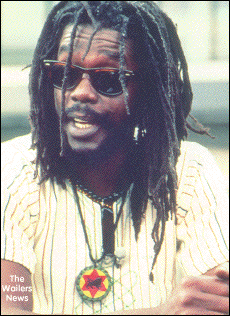

"I've learned some lessons in my life/lessons
in my life/Always be careful of my friends/be careful of my friends/Money
can make friendship end/it makes friendship end." - From "No
Nuclear War" by Peter Tosh.
To his fans around the world, Peter Tosh
was a rocking Rastafarian who smoked ganja on stage and musically
assaulted authority. To the oppressed people of Jamaica's ghettos, the
inspiration and reason for reggae, Winston Hubert McIntosh was a demigod.
But even demigods die.
Like his friend and compatriot, Bob Marley,
Tosh became a voice that cried out against injustice with protest music
born in the slums of Kingston. And like Marley, Tosh was silenced
prematurely.
Last weekend, three armed intruders broke
into Tosh's estate outside of Kingston and shot and killed the musician
and herbalist Wilton "Doc" Brown. Tosh's girlfriend and manager,
Marlene Brown, drummer Santa Davis, musician Michael Robinson and disc
jockey Jeff Dixon and his wife, Yvonne, were wounded in the attack.
Tosh was murdered a week after his album,
"No Nuclear War," one of his most ambitious recordings, was
released in the United States. "No Nuclear War" addresses the
issues of nuclear holocaust, apartheid, world peace and spirituality with
an upbeat mix of choppy reggae and a commercial pop slickness aimed at
international charts.
Tosh had spent the last four years involved
in contract disputes, and "No Nuclear War" was supposed to
establish him as the man to carry the burning spear of reggae into the
future and keep it as viable a music as rock - a role left vacant when Bob
Marley died of cancer in 1981.
Tosh was born in 1944 in Grange Hill, a
small town off Jamaica' s tourist track and near the island's mountainous
"cockpit country, " a large farming and agricultural area. When
Tosh was 17, his father abandoned the family, and the teenager moved with
his mother to Trench Town in Kingston.
Trench Town, the symbol of government
oppression in Tosh and Marley's reggae songs, is a conglomeration of
cement shacks and open sewers that serves as public housing. It is the
island's most notorious ghetto.
In 1963, Trench Town's aspiring musicians
gathered at the house of a local celebrity named Joe Higgs. Higgs was a
calypso-pop singer esteemed as much for his critical ear as for being a
star with a local hit and for being a hero on the streets. Hanging out at
Higgs', Tosh was one of few Jamaicans who owned - and knew how to play - a
guitar.
One day, while passing by Higgs' place,
Tosh heard the harmonizing of Marley and Neville O'Riley Livingston, who
would later become Bunny Wailer. Assertive and outspoken, Tosh took it
upon himself to join them.
While the British Invasion was still a
battle plan in England, these young Jamaicans were creating a new sound
that would eventually disrupt their country's politics before finding an
international audience and influencing many of today's young bands.
The three "Wailing Wailers," as
they were called in the beginning, were entranced with the vocal harmonies
of the Drifters and the Impressions, but the renegade sounds of the
Beatles, Rolling Stones and Bob Dylan didn't escape their notice. Under
the guidance of Clement Dodd, a founder of the Jamaican music industry,
the Wailers learned songwriting and how the business worked.
Eschewing the mellow happiness of the
contemporary Caribbean steel drum sound, the Wailers opted for pointedly
political music with a hard- driving beat straight from a hot, sweaty
night in a Trench Town shack. They added a punch and a harshness to
traditional Caribbean calypso that was energized by lives spent fighting
poverty, racism and oppressive colonial rule.
Their first hit, a recording called
"Simmer Down" that ridiculed the anarchistic preachings of the
Rude Boy movement in the ghettos, signaled what reggae was to become. It
became a music of political protest packed with a relentless beat that
gave the words power.
For Bob Marley and the Wailers, reggae also
became a string of hits that included "Rude Boy," "Trench
Town Rock," "Stir It Up" and the reggae anthem "Get
UpStand Up" - which Tosh and Marley co-wrote. With hits such as
these, the Wailers became folk heroes around the world and reggae royalty
in Jamaica.
And, along the road to stardom, the Wailers
found religion. They became Rastafarians. The Rastafarian faith is based
upon the life of the self-proclaimed son of God, Haile Selassie, ruler of
Ethiopia. On the ghetto battlefield, the Rastas were the spiritual
opposition to the physical anarchy of the Rude Boys.
Rastas are intensely spiritual. They praise
Jah, the creator, and practice a holistic naturalness known as I-tal. But
their ganja worship, permissive attitudes and long, springy tubes of hair,
called dreadlocks, never gelled with society proper.
Although the Rasta movement grew because of
the Wailers, by the time they released their first album, "Catch a
Fire," in 1972, the three musicians were already beginning to
dissolve a partnership that had survived years of mismanagement and deceit
during the hard scramble out of Trench Town.
As they grew from angry teens into cult
heroes, the three Wailers had shared songwriting credits and
responsibilities. The relationship started to strain, however, when the
Wailers went to London to record "Catch a Fire" under the
direction of producer Chris Blackwell of Island Records, a division of
Capitol.
In early 1973, when the Wailers made their
first North American tour, Bunny Wailer left the group, citing a fear of
flying. He was replaced by an enthusiastic Joe Higgs.
During the tour, a lukewarm response in
Canada and a frigid winter in London heightened tension between Tosh and
Marley. Finally, the two confronted each other in November 1973. Marley
dominated the reggae spotlight; Tosh left the group.
While Marley's star would rise, Tosh never
received the recognition that Marley did, even after Marley's death.
After Tosh left the Wailers, his music
became more radical and took an even stronger political stance. Though
that was popular with the Jamaican people, the authorities felt otherwise.
In 1975, after being busted for possession of ganja, Tosh was brutally
beaten by police officers. The incident agitated his political radicalism.
Meanwhile, detractors accused Tosh of selling out when he began recording
on the Rolling Stones' label in 1978.
Tosh's radical views attracted wide public
attention during the first Peace Concert in Kingston's National Stadium in
1978, which marked Marley's return to the Jamaican stage. Two years after
a politically motivated assassination attempt on Marley, Tosh preceded Bob
Marley and the Wailers on stage in their hometown. To open his set, Tosh
harangued then-Prime Minister Michael Manley and the Parliament, who were
sitting in the audience, for 30 minutes. At the end of his speech, in open
defiance of the scores of riot police "protecting" the stage,
Tosh lit up a huge ganja cigar.
In the late '70s and early '80s, Tosh
recorded the hits "Bush Doctor" and "Africa," as well
as new versions of "Get Up Stand Up" and the old Wailers tune
"Downpressor Man." His biggest hits - released while Marley was
still the reigning king of reggae - were the pot anthem "Legalize
It" and "(You Got to Walk and) Don't Look Back," a song he
co- wrote with Mick Jagger.
"No Nuclear War" is an example of
Tosh's desire to push reggae and the Rasta movement back into the
forefront of popular music. His previous albums dealt primarily with
racism, and the cover art was often pictures of him. This new album
tackles a more diverse array of issues, and the cover is a drawing of a
Rastafarian in a gas mask standing in front of a mushroom cloud.
Some solo albums: